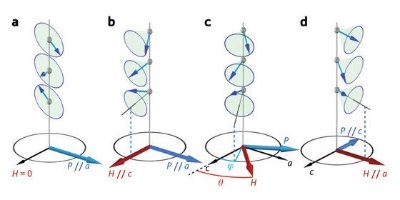Mar. 27, 2009 Research Highlight Physics / Astronomy
Twist and turn
Experiments with a rotating magnetic field provide new understanding on its coupling to the electric polarization of a multiferroic material
 Figure 1: Response of electric polarization, P, to a magnetic field, H. (a) In the absence of a magnetic field the polarization points to the crystal axis a. (b) If a magnetic field is applied in c-direction, the cycloids evolve into a conical structure. (c) As the magnetic field is turned at an angle of θ, the polarization moves by a similar angle, ϕ. (d) As H points towards a, a complete 90° rotation is completed. Reproduced, with permission, from Ref. 1 © 2008 by the American Physical Society
Figure 1: Response of electric polarization, P, to a magnetic field, H. (a) In the absence of a magnetic field the polarization points to the crystal axis a. (b) If a magnetic field is applied in c-direction, the cycloids evolve into a conical structure. (c) As the magnetic field is turned at an angle of θ, the polarization moves by a similar angle, ϕ. (d) As H points towards a, a complete 90° rotation is completed. Reproduced, with permission, from Ref. 1 © 2008 by the American Physical Society
The electric polarization of a multiferroic material is linked directly to its magnetism, which allows the control of magnetism with electric fields and vice versa. Researchers at RIKEN’s Advanced Science Institute in Wako, in collaboration with scientists from the University of Tokyo, have now studied how the electric polarization of multiferroic materials responds to changes in an externally applied magnetic field.
To date, the number of known multiferroic compounds is limited to a few oxide compounds. Furthermore, in most multiferroics the coupling of the magnetic field and electric polarization, or multiferroic coupling, is rather small, particularly at room temperature. However, some oxide compounds, such as Eu0.55Y0.45MnO3, have a strong multiferroic coupling, albeit only at relatively low temperatures.
Common to this novel class of multiferroics is an arrangement of atomic magnetic moments, or spins, in the form of either a helix or a cycloid where the spins have a slightly different orientation to their neighbors. It is this cycloidal arrangement that creates an electric polarization (Fig. 1a).
As reported in Physical Review Letters 1, the researchers studied the influence of a rotating magnetic field on the cycloidal spins, which consequently start to follow the external rotation. They have found that in the presence of a magnetic field perpendicular to these cycloids, the atomic spins tilt towards the direction of the magnetic field, and a conical structure develops (Fig. 1b). The conical structure preserves the handedness of the cycloid structure, so as the magnetic field rotates around the cycloid axis (Fig. 1c,d), the electric polarization rotates in similar fashion.
When the researchers applied the rotating external magnetic field in the direction of the cycloids, the response of the electric polarization was slightly more complex as the cycloids react slightly different to tiny variations in magnetic field. However, they noted that the electric polarization still responds very sensitively to the magnetic field.
The team studied the multiferroic material Eu0.55Y0.45MnO3, but their results apply to all related compounds. “The electric polarization is highly sensitive to the rotation of the magnetic field, which illustrates how these multiferroics may be used as a magnetic sensor,” comments team member Shintaro Ishiwata on the implications of their findings.
These findings are important to detail the dynamics of the multiferroic coupling; however the operational temperatures for these helical multiferroics are currently limited to cryogenic temperatures and this restricts their technical application. “Our ultimate goal is to find a material that works at room temperature operation,” stresses Ishiwata.
References
- 1. Murakawa, H., Onose, Y., Kagawa, F., Ishiwata, S., Kaneko, Y. & Tokura, Y. Rotation of an electric polarization vector by rotating magnetic field in cycloidal magnet Eu0.55Y0.45MnO3. Physical Review Letters 101, 197207 (2008). doi: 10.1103/PhysRevLett.101.197207
